The one face cream we should all be using every day
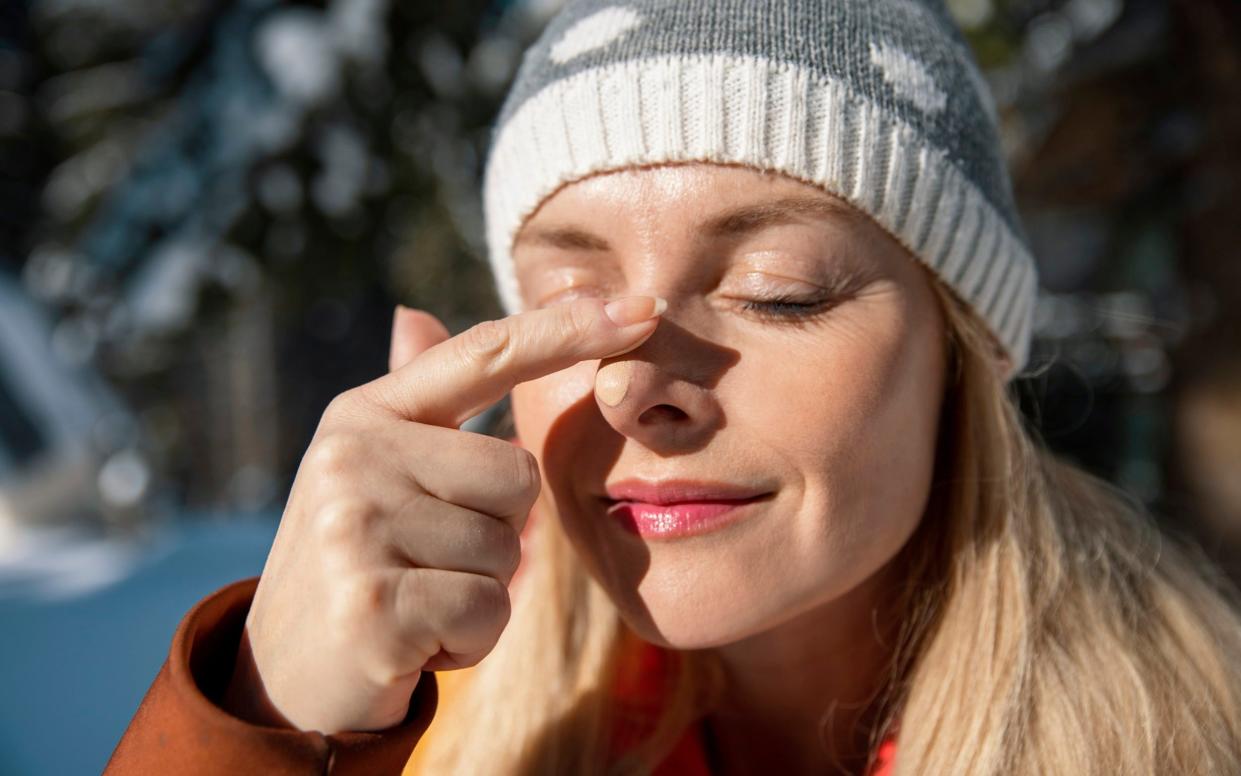
If you need real-life evidence that sun exposure is the main cause of premature ageing, then you only have to look at your bottom, according to consultant dermatologist Dr Emma Wedgeworth. As we age, the skin on the buttocks (provided you haven’t partaken in regular bum-exposing sunbathing) remains free from pigmentation and wrinkles compared with our hands or face, which are cumulatively subjected to UV exposure – even through clouds and windows.
That’s not to say that when the sun shines we should remain inside in the dark for fear of a few wrinkles. With skin cancer being the fifth most common cancer in the UK and UV light the main cause of premature ageing, protecting your skin from the effects of sun exposure should be a priority. It’s so important, in fact, that the beauty industry body the British Beauty Council is campaigning to have suncare protection categorised as a daily skincare essential, making it exempt from VAT taxation.
Sun worshippers often pose the argument that vitamin D from being in the sun is vital to our immune system. And yet, according to the charity the British Skin Foundation, for lighter skin types, 10-15 minutes of daily sunlight between April and September provides sufficient year-round vitamin D, while also minimising the risks of sunburn and skin cancer. For darker skin types, 25-40 minutes is recommended. If you take the average number, you’re talking no more than a 30-minute walk once a day without sun protection.
Despite the overwhelming evidence that ultraviolet radiation causes skin damage, research conducted by Boots No7 found that only 40 per cent of the 3,000 women aged 16-24 surveyed believe it is necessary to wear sun protection every day, even if the weather isn’t warm or sunny.
Let’s separate fact from fiction.
UVB and UVA
When choosing sunscreen, it is worth knowing that the SPF factor relates to the level of UVB protection. UVB is radiation responsible for burning skin and is known to contribute to skin cancer - therefore, the higher the SPF factor of a sunscreen, the more protection you get. UVA, meanwhile, is responsible for damaging collagen synthesis (the process that makes skin look youthful and smooth) and exacerbates skin conditions such as melasma and hyperpigmentation, prematurely leading to wrinkles and sagging.
Therefore, it’s wise to opt for a sunscreen that offers broad spectrum UVB and UVA protection, says consultant dermatologist Dr Mary Sommerlad, who warns that despite UVA being known as “the ageing ray”, it can also contribute to skin cancer. There are a number of rating systems on sunscreen bottles that determine the level of protection from UVA radiation. Some carry a rating known as PA, which was first developed in Japan as a UVA grading system. PA+ means some UVA protection, PA++ equates to moderate, PA+++ is high, and PA++++ gives extremely high UVA protection. The European rating is illustrated with the letters UVA within a circle, which means the UVA protection is at least a third of the SPF value and meets EU regulations.
Boots has developed its own star system to minimise confusion, with five stars being the highest level of UVA protection. Sommerlad says she often steers her clients towards Boots for another reason: “Boots have a stringent quality-control system,” she notes. “They test each brand they stock independently to confirm the level of protection is equivalent to the claims on the product.”
Is tanning safe?
Whether or not your skin tans shouldn’t be the main metric, says Dr Wedgeworth. “Some skin types will tan more easily than others, depending on their skin tone, therefore a tan doesn’t necessarily mean that you’re damaging your skin.”
What people should be concerned about, she says, is burning. “Sunscreens won’t stop you from tanning completely, but they will help to prevent damage. The key is to make sure not to change your natural colour too much. And never get burnt,” she says, warning that five episodes of burning over 10 years will double your risk of skin cancer. “People take burning a bit too lightly. It is very damaging,” Dr Wedgeworth adds.
Mineral vs chemical
In recent years, chemical sunscreens have been pitted against mineral SPFs. “Chemical sunscreens work by absorbing UV radiation whereas physical or mineral sunscreens such as titanium dioxide work by reflecting UV light,” says Mike Bell, the head scientist for Boots No7, emphasising that each has their pros and cons. “Mineral sunscreens can be thicker and for skin of colour can leave a white cast,” he says. Chemical sunscreens, meanwhile, though often sheer and nicer to use under make-up, have the telltale SPF scent that can put people off.
For some the concern is whether or not chemical filters are dangerous. “There’s no credible evidence that chemical filters get into the bloodstream. They stay on the surface of the skin providing a film of sun protection that’s very safe,” says Bell.
Dr Sommerlad adds: “All sunscreens, even mineral ones, have to go through a chemical process in a lab. The best sunscreen is the one you’ll use every day, and that’s the best thing you can do to protect your skin from damage.”
Antioxidants: the third shield
Ultraviolet light isn’t only made up of UVA and UVB. HEV (high-energy visible) or blue light can also be ageing. Whereas UVA penetrates deeper into the skin than UVB, damaging collagen and driving premature ageing, HEV, says Dr Sommerlad, goes even deeper, creating oxidative stress that breaks down collagen and elastin and drives pigmentation. To protect against free radical damage, antioxidants are a complementary ingredient to sunscreen protection, either via a skincare serum worn underneath a broad spectrum facial SPF or within a sunscreen that contains antioxidants.
Alternatively, you can take an antioxidant supplement such as Heliocare 360 D Plus Capsules that contains vitamin D and a supercharged antioxidant proven in clinical trials to protect against light-induced pigmentation and prevent collagen breakdown while improving the efficacy of UV filters by up to 14 per cent.
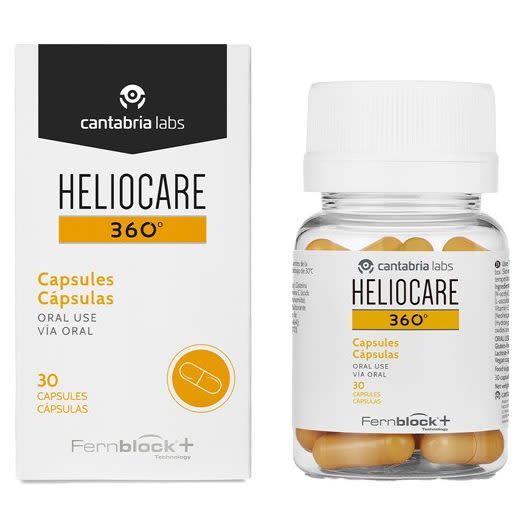
Heliocare 360 D Plus Capsules, £27.99, Look Fantastic
Unlike other “sun pills” that harness beta-carotene, another antioxidant, Dr Wedgeworth says that beta-carotene isn’t shown to have a protective effect on skin like the proprietary ingredient in Heliocare’s supplements, polypodium (a rare plant that grows in Central and South America), which has more robust data when it comes to free radical protection.
The forgotten body parts
In many cases, our hands age quicker as we often neglect to protect them from sun exposure. But our ears, lips and decolletage are equally vulnerable to skin damage, including skin cancer, when sunscreen isn’t applied, hence why it’s smart to find a product that’s affordable to use on a wide surface area daily. You should use two full finger lengths’ worth of product on the face alone for adequate UV protection. A simple rule: facial skincare, including SPF, should end at your nipples, particularly in summer, when your neck and decolletage are exposed.
Darker skin
We know that darker skin needs more time to absorb vitamin D from the sun than lighter skin tones, but that doesn’t mean skin of colour isn’t prone to sun damage or, indeed, skin cancer. “Skin cancer occurrence is relatively low in skin of colour, but it’s not entirely immune,” says Dr Sommerlad.
“Some skin tones, particularly those who are of mixed heritage can be more prone,” she explains, pointing out that you can’t group all skins of colour together and that someone’s skin tone isn’t the entire picture – genetics and lifestyle should also play a part in determining what level and type of sun protection is best. “If one of your parents is white and you have green eyes and lots of freckles, then your skin is more prone to damage than that of someone with very dark skin, therefore it’s important to consider and treat each person’s skin individually regardless of how one identifies,” she stresses.
Meanwhile, “olive, brown and light Asian skin are more prone to pigmentation or melasma,” says Dr Sommerlad. “This happens when UV light awakens a certain type of melanocyte receptor which can then overproduce pigment days after sun exposure.” In this instance it’s key not only to shield from the sun but to look out for skincare products with ingredients that help to regulate pigmentation, such as niacinamide.
6 of the best new facial SPFs
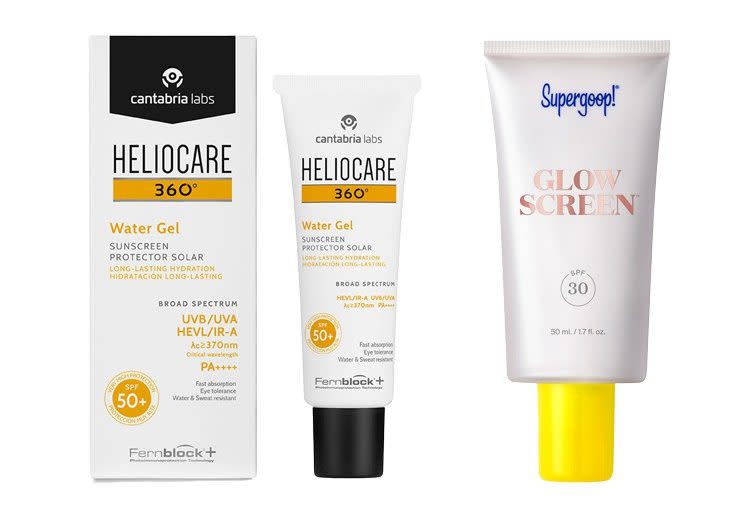
Heliocare 360 Water Gel Colour Sunscreen
A hydrating sunscreen with high UVA and UVB protection, this is a light gel, making it perfect for under make-up or for those with oily skin. However, it’s suitable for all skin types and includes skincare ingredients that it claims increase hydration by 70 per cent.
Supergoop! Glowscreen SPF30
Available in four shades, this radiance-boosting sun shield is a hybrid between a glow-giving skin cream and sunscreen. It contains hyaluronic acid, antioxidants and vitamin B5.
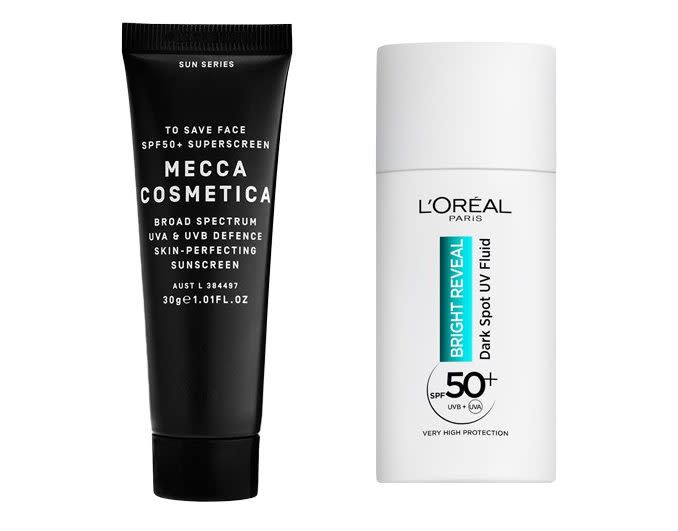
Mecca Cosmetica To Save Face SPF50+ Facial Sunscreen
A light chemical sunscreen that leaves no white cast and goes on with a slight tint that gives skin a glow. It is made in Australia, where sunscreen regulations are strict, so you can rest assured you’ll be adequately protected.
L’Oréal Paris Bright Reveal Dark Spot UV Fluid SPF50+ Niacinamide
This clever facial sunscreen helps to prevent pigmentation and even skin tone, with the addition of skincare hero niacinamide, which also protects the skin barrier.
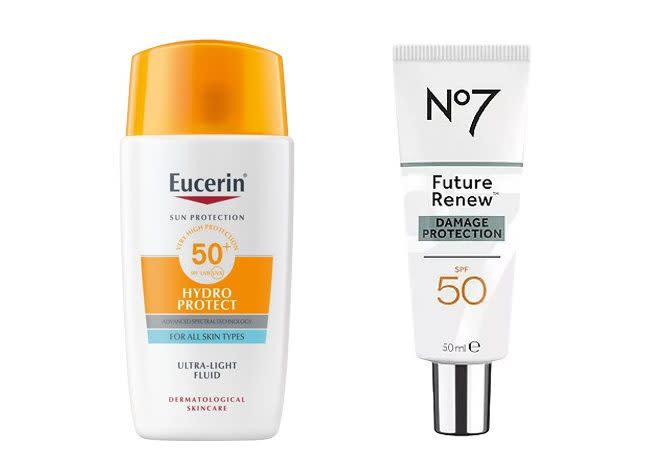
Eucerin Hydro Protect Ultra Light Fluid 50+
Suitable for all skin types, this light fluid offers high protection against HEV, UVA and UVB, while neutralising free radicals and hydrating skin.
No7 Future Renew UV Defence Shield
A smart complement to Future Renew’s face serum, which it claims is proven to reverse sun damage over the long term, this light fluid will protect against future damage and help halt accelerated ageing.


